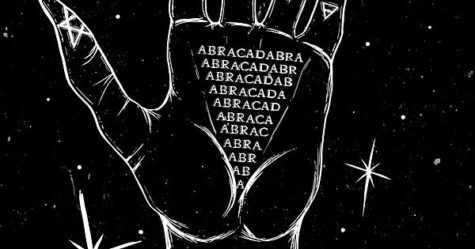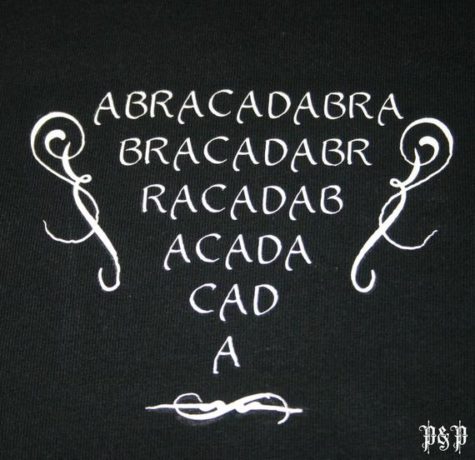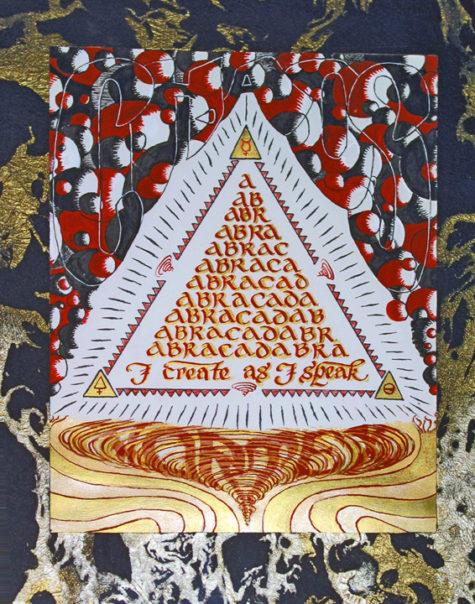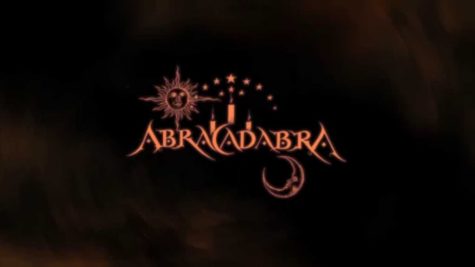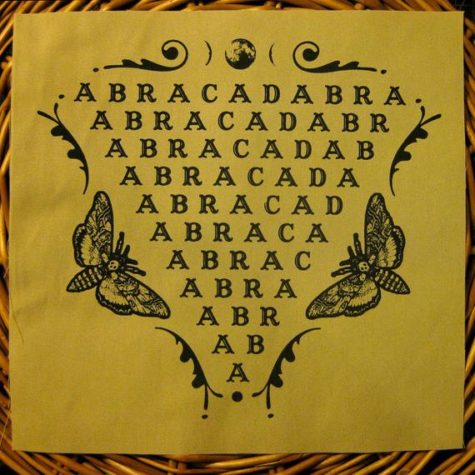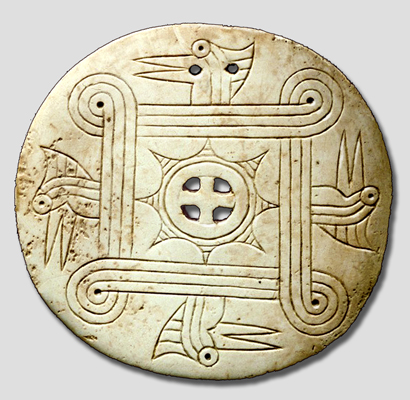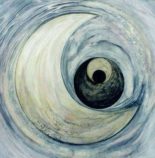Talisman
Abracadabra
Nowadays, “abracadabra” is a word used by stage conjurers when performing their magic. However it has a lengthy history as a protective amulet and lucky charm.
This word is extremely ancient and originally was thought to be a powerful invocation with mystical powers. This ancient word may well have been inspired by the Aramaic: “Avra Kedabra” which means, “I create as I speak” or words to that effect. Its origin is unknown, but Cabalists were using it in the second century CE to ward off evil spirits.
It is most often used magickally as a charm, and written as a triangular formula:
A B R A C A D A B R A
A B R A C A D A B R
A B R A C A D A B
A B R A C A D A
A B R A C A D
A B R A C A
A B R A C
A B R A
A B R
A B
A
In the Middle Ages, many people believed wearing parchment amulets with the word “abracadabra” written in the form of an upside-down pyramid would cure fevers, toothache, warts, and a variety of other ailments. It would also protect the wearer from bad luck. The word was written eleven times, dropping one letter each time.
Sometimes letters would be sequentially removed from each end of each line, making for a shortened version consisting of just six lines.
The idea was that as the word vanished, so would the fever. An amulet of this sort was attached to linen thread and worn around the neck. It was usually worn for nine days and then discarded.
The best way to do this was to toss it backwards over your left shoulder before sunrise into a stream that flows from west to east. The reason for this s that the left side was believed to be related to the devil. Tossing the amulet into a river that flowed in the direction of the rising sun symbolically banished the evil, and replaced it with the good created by the rising sun that banishes darkness.
Daniel Defoe wrote about these charms in his Journal of the Plague Year (1722), saying that they were worn to protect people from the plague.
Even saying the word “abracadabra” out loud was believed to summon powerful supernatural forces. This is probably why magical entertainers still use it as a magic spell today.
It does matter which direction the Abracadabra is pointed. Pointed downwards, it will help you to rid yourself of evil and misfortune, when pointed upwards, it will bring good fortune.
It was first recorded in a Latin medical poem, De medicina praecepta, by the Roman physician Quintus Serenus Sammonicus in the second century AD. Serenus Sammonicus said that to get well a sick person should wear an amulet around the neck, a piece of parchment inscribed with a triangular formula derived from the word, which acts like a funnel to drive the sickness out of the body.
Theories about the origin of this word are as follows:
It was derived from the Hebrew phrase “Abreq Ad Habra” meaning “Hurl your thunderbolt unto death” or “Strike dead with thy lightning;”and is associated with a thunderbolt deity who perished by throwing himself on the planet so that the creatures of earth could live. In this case its efficacy as a charm to ward away illness would make sense.
It originated with a Gnostic sect in Alexandria called the Basilidians and was probably based on Abrasax, the name of their supreme deity (Abraxas in Latin sources).
It may have come into English via French and Latin from a Greek word abrasadabra (the change from s to c seems to have been through a confused transliteration of the Greek).
It could be from the Aramaic “Abhadda Kedabhra” meaning “Disappear as this word,” which accurately reflects exactly what happens in the charm. As the word diminishes and finally disappears, so would any malevolent energy.
The first letters of the word could be derived from the initials of Hebrew words for Father (Ab), Son (Ben), and Holy Spirit (Ruach Acadsch).
Chances are that this is such a powerful symbol because all of these theories make sense, so it would have universal appeal.
Although most accounts say that the charm was in use until the Middle Ages, there’s curious proof of its efficacy in a small thirteenth-century church in a remote valley in Wales in the U. St. Michael and All Angels Church at Cascob on the edge of the Radnor Forest has an Abracadabra charm engraved on a tablet on one of its walls. In the seventeenth century a local girl, Elizabeth Lloyd, was apparently possessed of evil demons, and this symbol was used to drive them away, along with the astrological symbols that are carved below. There’s even a possibility that this tablet was made by the alchemist Sir John Dee, who was an astrologer to Queen Elizabeth 1, and lived nearby.
Fans of the Harry Potter books will know the killing curse, Avada Kedavra, in which J K Rowling seems to have combined the Aramaic source of abracadabra with the Latin cadaver, a dead body.
Sources:
- The Element Encyclopedia of Secret Signs and Symbols
- The Encyclopedia of Superstitions
Agaku
From the Fifty Names of Marduk in the Necronomicon Spellbook.
The Sixteenth Name is AGAKU.
This Power can give live to what is already dead, but for a short time only. He is the Lord of the AMULET and the TALISMAN. His word is MASHGARZANNA.
Some explanation is necessary to understand the full implications of AGAKU. The bestowing of life into dead objects is a specialty of those magicians who deal in TALISMANIC magick. In this ART, a drawing or engraving is made of some occult symbol that represents a goal to be achieved (to make an extreme case, drawing a dollar sign on a piece of paper to represent money or wealth). This ‘talisman’ must then be consecrated and given ‘life’, which is the life-force and True Will of the magician transmitted to the Talisman. AGAKU can assist the budding magician by expediting this transfer of life-force to the talisman.
Important note:
“The Signs and Powers may be summoned after the Priest has ascended to that step on the Ladder of Lights and gained entrance to that Sacred City. The Signs should be engraved on parchment or sealed in clay and placed upon the altar at the Calling. And in the perfumes should be of cedar, and strong, sweet-smelling resins. And the Calling be to the North.”
More information:
According to Sumerian mythology, Marduk was the God who defeated the Ancient Ones long before the creation of matter as we know it.
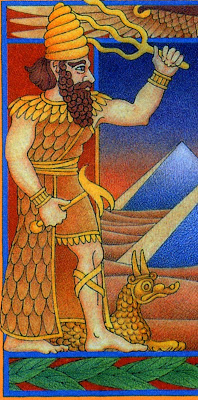 Against him in battle were the fierce TIAMAT, KINGU, and AZAG-THOTH. Once he had destroyed these demons, he created the universe from the flesh of TIAMAT, and humanity from the blood of KINGU mixed with his own breath.
Against him in battle were the fierce TIAMAT, KINGU, and AZAG-THOTH. Once he had destroyed these demons, he created the universe from the flesh of TIAMAT, and humanity from the blood of KINGU mixed with his own breath.
You will come across these names in the description of the Fifty Names, which were titles given to Marduk by the Elder Gods after he had helped them to defeat the Ancient Ones.
Related links:
- Pagan Calendar – Marduk’s Feast Day
- The Powers That Be – Marduk The God
- Widdershins – Marduk Legends and Stories, the original translation of the Enûma Eliš, and the Fifty Names of Marduk as originally given in the ancient tablets.
The Cox Mound Gorget
The Cox Mound, or Woodpecker, gorget style is a particularly beautiful and enduring symbol of Tennessee’s prehistoric inhabitants. A gorget was a pendant, or personal adornment, worn around the neck as a badge of rank or insignia of status and was thought to be symbolic of both earthly and supernatural powers. A variety of gorget styles, or designs, are known. As a class of artistic expression, this type of artifact falls within the Southeastern Ceremonial Complex, formerly known as the Southern Cult.
Just over thirty Cox Mound-style gorgets have been found since the late nineteenth century, primarily from prehistoric Mississippian stone box graves and villages along the lower Tennessee, Cumberland, Duck, Harpeth, and Buffalo Rivers of Middle Tennessee, and the middle Tennessee River valley of northern Alabama. As a result of the frequent mortuary association of Cox Mound gorgets with certain pottery types, namely Matthews Incised, as well as other artifacts, it has been postulated that Cox Mound gorgets date to the period A.D. 1250-1450. One rich grave from the famous burial mound at the Castalian Springs site in Sumner County produced two Cox Mound gorgets.
Typically, Cox Mound gorgets were manufactured on exotic marine shell and were white in color. Other materials, such as black slate in Putnam County and human skull fragments in Hardin County, were used rarely. Engraving the intricate design on the hard shell or slate without metal tools took many hours of skilled labor and is thought to have been a winter activity.
A Cox Mound gorget has three important iconographic elements. In the center is a cross inside a rayed circle or sun motif. The cross is symbolic of the sacred, or council, fire. The sun represents the sky deity and/or mythical ancestors. Surrounding the cross and sun is a scroll-like design element known as the looped square. This feature may represent wind, or possibly the litter on which subordinates carried a chief.
Typically the looped square is composed of four lines, but in some cases only three lines are used. Four crested bird heads, which most scholars interpret as woodpeckers, are found on the outer edge. The woodpecker heads always are oriented in a counterclockwise direction, suggestive of the prehistoric Native American swastika.
The woodpecker, like the falcon, was probably a symbol of war to the prehistoric Mississippian Indians. The war symbolism of the bird probably derived from the red head of the bird, which resembled a bloodied scalping victim. The Cherokees associated the red-headed woodpecker with danger and war, and the woodpecker was always invoked for aid by the ball game players. The bird’s pecking is similar to an Indian warrior striking the war post at the Victory dance. For the Cherokees, the color red is associated with male attractiveness and fertility, as well as bravery and war. Groups of woodpeckers are thought to be a sign of war to the Creeks and Seminoles. While war is typically associated with males in Native American society, it is important to note that Cox Mound gorgets have been found in both male and female burials.
Other interpretations include the identification of the four woodpeckers as the four thunders at the world quarters, and a folklorist has speculated recently that the Cox Mound gorget style is a prehistoric expression of the Yuchi myth of the Winds. Cox Mound gorgets are displayed by the Tennessee State Museum and Pinson Mounds State Archaeological Area.
Source: Tennessee Encyclopedia
